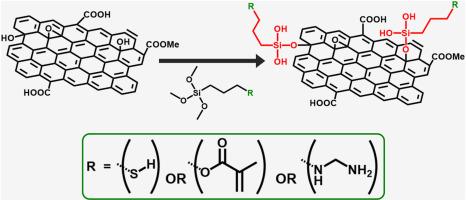石墨烯纳米片的硅烷功能化
IF 8.2
2区 材料科学
Q1 MATERIALS SCIENCE, MULTIDISCIPLINARY
引用次数: 0
摘要
高sp2杂化、低氧含量(<10 atm%,C:O >9:1)的石墨烯纳米片(GNP)缺乏功能化的简便途径,这极大地阻碍了对这些材料的充分利用。此外,即使在液氦温度下,GNP 的高导电性和顺磁性也会使人们无法使用固态核磁共振光谱(SS-NMR)和电子顺磁共振光谱(EPR)来证明硅烷与 GNP 表面的结合是否成功。在这里,3-巯丙基三甲氧基硅烷、3-甲基丙烯酰氧基丙基三甲氧基硅烷和 N-(2-氨基乙基)-3-氨丙基三甲氧基硅烷这三种模型硅烷成功地结合到了 GNP 表面,每种硅烷都是通过缩合硅烷化反应或取决于每种硅烷的 R 基团的途径结合到 GNP 表面的。研究人员采用了多种技术,但最关键的是,在氩气和空气中结合使用 X 射线光电子能谱分析法(XPS)和热重分析-质谱分析法(TGA-MS)证实了硅烷与 GNP 的成功结合。所采用的方法使硅烷上的悬垂 R 基团可以与聚合物发生相互作用或反应,并提供了一条显著改变聚合物和表面特性的途径。本文章由计算机程序翻译,如有差异,请以英文原文为准。

Silane functionalization of graphene nanoplatelets
The lack of a facile route for the functionalization of highly sp2 hybridized, low oxygen content (<10 atm%, C:O > 9:1) graphene nanoplatelets (GNP) has greatly hindered full exploitation of these materials. Moreover, the highly conductive and paramagnetic properties of GNP can exclude the use of solid-state nuclear magnetic resonance spectroscopy (SS-NMR) and electron paramagnetic resonance spectroscopy (EPR), even at liquid helium temperatures, to prove binding of silane to the GNP surface is successful. Here, three model silanes, 3-Mercaptopropyltrimethoxysilane, 3-Methacryloxypropyltrimethoxysilane and N-(2-aminoethyl)-3-aminopropyltrimethoxysilane were successfully bound to the surface of GNP, each following either a condensation silanization reaction or a pathway dependent on the R-group of each silane. Several techniques were employed, but critically a combination of X-ray photoelectron spectroscopy (XPS) and thermogravimetric analysis-mass spectrometry (TGA-MS) in argon and air confirmed successful binding of the silane to the GNP. The approach adopted makes available the pendant R-group on the silane for interaction or reaction with polymers and a route to significantly modifying the properties of polymers and surfaces.
求助全文
通过发布文献求助,成功后即可免费获取论文全文。
去求助
来源期刊

Materials Today Nano
Multiple-
CiteScore
11.30
自引率
3.90%
发文量
130
审稿时长
31 days
期刊介绍:
Materials Today Nano is a multidisciplinary journal dedicated to nanoscience and nanotechnology. The journal aims to showcase the latest advances in nanoscience and provide a platform for discussing new concepts and applications. With rigorous peer review, rapid decisions, and high visibility, Materials Today Nano offers authors the opportunity to publish comprehensive articles, short communications, and reviews on a wide range of topics in nanoscience. The editors welcome comprehensive articles, short communications and reviews on topics including but not limited to:
Nanoscale synthesis and assembly
Nanoscale characterization
Nanoscale fabrication
Nanoelectronics and molecular electronics
Nanomedicine
Nanomechanics
Nanosensors
Nanophotonics
Nanocomposites
 求助内容:
求助内容: 应助结果提醒方式:
应助结果提醒方式:


